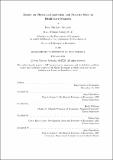Essays on physician innovation and practice style in healthcare markets
Author(s)
Badinski, Ivan Nikolaev.
Download1252059179-MIT.pdf (2.827Mb)
Other Contributors
Massachusetts Institute of Technology. Department of Economics.
Advisor
Amy Finkelstein, Heidi Williams and Tobias Salz.
Terms of use
Metadata
Show full item recordAbstract
This thesis consists of three chapters on technological innovation, diffusion, and practice style among physicians. The first chapter investigates the effect of age on a surgeon's propensity to use new medical procedures. I identify a large number of medical technologies undergoing diffusion by a well-defined risk set of physicians by exploiting the parent-descendant relationship among ICD9-CM inpatient procedure codes where each new code has a well-defined antecedent. I find that surgeons that are ten years older at the time of new-code approval are sixteen percent less likely to use this code. Evidence from the diffusion of new pharmaceuticals, diagnostic codes, and minimally invasive procedures suggests that this effect may be driven by skill acquisition costs rather than information frictions. In the second chapter, I study the impact of market size on the development of novel surgeries, an important domain of medical innovation where intellectual property rights, approval regulation, and financial incentives play only a minor role. Using the codification of ICD9 CM procedure codes as a novel measure of new-surgery development, I investigate the behavior of surgical innovation and compare it to pharmaceuticals where traditional innovative institutions are salient. I find that the two processes follow very different aggregate trends. Despite this difference, I estimate a positive and significant elasticity of surgical innovation with respect to potential market size by leveraging quasi-exogenous changes in potential market size due to shifting US demographics. The third chapter, joint with Amy Finkelstein, Matthew Gentzkow, Peter Hull, and Heidi Williams, studies the role of physician practice style in Medicare geographic spending variation. We estimate a model that allows for variation in patient demand, physician treatment intensity, and regional supply-side factors, as well as patient-physician sorting. The model is identified by quasi-experimental migration of Medicare patients and physicians and their matching within regions. We find that physicians vary greatly in their treatment intensity. Our baseline decomposition suggests that about 30 percent of regional variation in health care utilization is explained by differences in average physician treatment intensity, 20 percent by other area supply factors, and 50 percent by differences in patient demand.
Description
Thesis: Ph. D., Massachusetts Institute of Technology, Department of Economics, February, 2021 Cataloged from the official PDF of thesis. Includes bibliographical references (pages 167-182).
Date issued
2021Department
Massachusetts Institute of Technology. Department of EconomicsPublisher
Massachusetts Institute of Technology
Keywords
Economics.